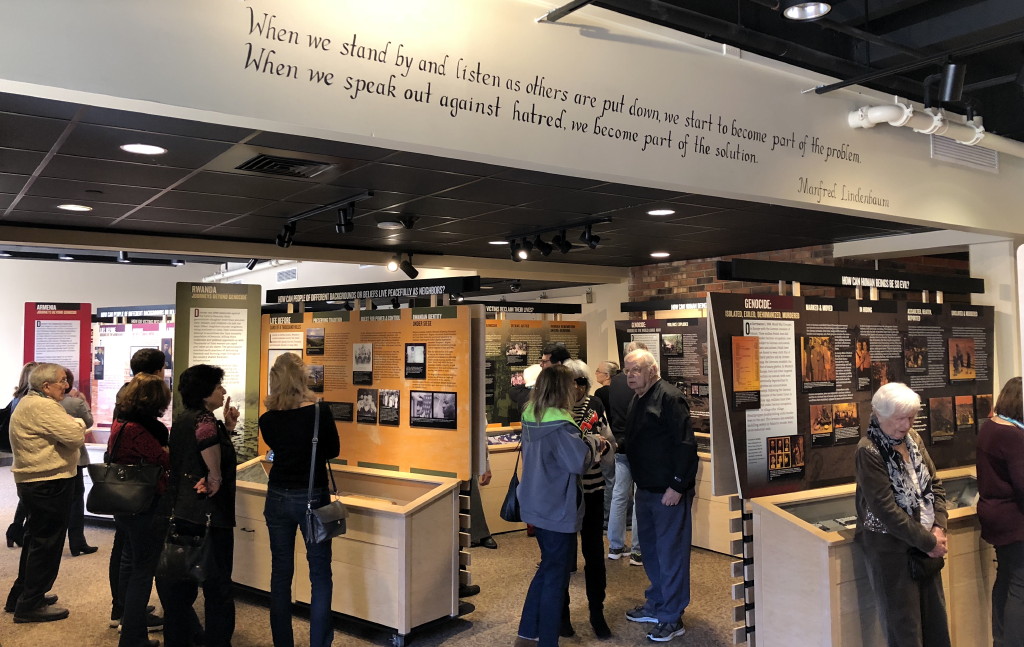“Journeys Beyond Genocide: The Human Experience” is the new exhibit that the Center for Holocaust, Human Rights and Genocide Education has opened at Brookdale Community College in Lincroft.
In a statement from the non-profit organization, Chhange, which was established in 1979, carries out its mission to educate about the Holocaust, human rights and genocide; promote the elimination of all forms of prejudice; and develop creative programs regarding these crucial human issues.
Chhange Executive Director Dale Daniels said the idea for the exhibit developed when she met and spoke with numerous Holocaust survivors and realized that many were dying.
“I said, I have to find a way to preserve their teachings, because they…[are] master teachers and when they would testify and give testimonies – in front of our students especially – it was always a life-changing experience,” Daniels said.
The exhibit is unique because it explores three genocides: the Armenian Genocide, the Holocaust and the 1994 Genocide against the Tutsi in Rwanda. It truly is a one-of-a-kind exhibit because of the focus on the Armenian Genocide and the 1994 Genocide against the Tutsi in Rwanda, both of which do not have permanent exhibits in the Tristate area, according to a statement from Chhange.
More than 140 locals attended the public opening of Chhange’s latest exhibit on April 8, at the Chhange Exhibit Gallery at Brookdale Community College’s Bankier Library Building, which is located at 765 Newman Springs Road.
“Our first exhibit was at the Monmouth Museum and it was on the Holocaust alone and it had a small section on other genocides. As soon as we got involved with that, I realized that it still wasn’t meeting the needs of Chhange because we teach about human rights abuses and other genocides, so how do we broaden it?” Daniels said.
Once Project Co-Director Susan Yellin came onboard to help create the exhibit, Daniels said, “We decided that since our focus is always on the human story, we wanted to focus on survivors in our community. We have Holocaust survivors; we have a huge community of local Armenians, who are descents of survivors, and then we had some local Rwandan survivors, so that became the driving force. They represent different time periods, in different continents and different experiences, but there are some commonalities, so we thought that was a good way to go forward.”
The exhibit uses testimony and archival objects from local survivors to make personal history the dynamic vehicle with which visitors can connect the lessons of genocide to today’s world, according to a statement from Chhange.
Daniels said the exhibit features 60 to 70 local survivors’ stories.
“When students and visitors come to the exhibit, it’s one thing to see that it’s a survivor’s [story], but when you know that it could be your neighbor, it could have been somebody who could have been your grandmother’s friend or your parents’ friend or your friend, it makes it much more heartfelt and it’s much more relatable,” Yellin said.
At the exhibit, each of the three genocides are broken down into four sections that includes: Life Before, Life At-Risk, Genocide and Recreating Life. Furthermore, each section has lead-in and lead-out questions to help guide visitors in terms of what they should think about has they go through the exhibit, according to Yellin.
“The last section in every exhibit has to do with response, so how individuals and countries respond to genocide,” Yellin said.
Daniels said Chhange really recommends visitors visit only one genocide per visit.
“There is so much information to gather and to focus on it as you should, we don’t want you to get confused,” Daniels said. “We feel that there is enough in one genocide to learn about; however, everybody at the end of their visit goes to see our final section, which is ‘Stand Up for Human Rights’ and that is focused on different crises in our world today. You learn about it, you process it and right here we give you ways to take action to address it.”
Yellin said the exhibit has close to 100 archival items.
“We made a decision in our design that we would have authentic items. We were trying to steer away from replicas because we want our visitors to know that they are witnessing the real thing,” Yellin said. “Chhange is the only Holocaust Genocide archive in the state of New Jersey and we currently house over a thousand archival items. So from time to time, the items you see might be rotated out, both to preserve them and also to make the visitors experience more enjoyable and refreshing.”
For each section of the exhibit, there also are drawers that contain archival items, which relate to a specific survivor’s story that visitors can pull open, according to Yellin.

